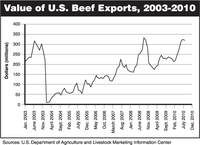Age, Source Verification May Open Beef Markets
(Click the image below to view a high-resolution image that can be downloaded)
U.S. beef exports have risen to levels the cattle industry has seen only once since December 2003, when the first case of bovine spongiform encephalopathy was discovered in the country.
However, U.S. cattle producers face stricter regulations if they plan to market their beef overseas. For example, Japan won’t accept cattle for slaughter more than 20 months old, and Korea won’t take cattle more than 30 months old.
Other countries also want to know the source of the meat they import.
“Producers who plan to sell their cattle for overseas markets need to be able to verify the age and source of their cattle, and that verification needs to be done by a third party,” says Karl Hoppe, Extension Service area livestock specialist at North Dakota State University’s Carrington Research Extension Center.
“Weaning time this fall is a good opportunity for producers to enroll in an age- and source-verification program,” he adds. “While calves are being processed for health issues, an approved third party-certified electronic ear tag can be placed in cattle.”
Many age- and source-verification programs are available for cattle producers. One of the first was the North Dakota Beef Cattle Improvement Association’s CalfAID program. The North Dakota Agriculture Department recently launched the North Dakota Verified Livestock program. It contracts with AgInfoLink USA, a federally licensed, Colorado-based company that has extensive experience with similar programs in other states, to provide the age and source verification.
For more information about North Dakota Verified Livestock, visit http://www.northdakotaagconnection.com/story-state.php?Id=675&yr=2010. A list of programs is available at http://www.ams.usda.gov/AMSv1.0/getfile?dDocName=STELPRD3320450.
Producers who enroll in a program complete training to help them understand the program’s requirements. Most programs also require producers to place an electronic identification (EID) ear tag on their animals.
How a program determines age varies. Some base a calf’s age on the birth date of the oldest calf in the herd. Others base it on each calf’s actual birth date.
Feedlots also need to be enrolled in a third-party verification program if they are feeding cattle for markets that require age and source verification. The North Dakota Verified Livestock program verifies age and source for feed yards.
“Participation in a source- and age-verification program is voluntary,” Hoppe says. “While most cattle are sold without any age or source verification, the segment that is verifying age and source is growing.”
As an incentive, meat packing plants may pay cattle feeders a premium at slaughter for cattle that are age and source verified. Premiums are ranging from $2 to $3 per hundredweight, according to Tim Petry, NDSU Extension livestock marketing economist.
“To receive a premium, fed cattle must be verified as 20 months of age or younger and delivered to select packing plants on days when age-verified cattle are slaughtered,” Petry says.
“While electronic identification tags and source verification don’t guarantee a premium at market time, it might open market access that can lead to returns in future calf sales,” Hoppe says.
NDSU Agriculture Communication
| Source: | Karl Hoppe, (701) 652-2951, karl.hoppe@ndsu.edu |
|---|---|
| Source: | Tim Petry, (701) 231-7469, tim.petry@ndsu.edu |
| Editor: | Ellen Crawford, (701) 231-5391, ellen.crawford@ndsu.edu |


